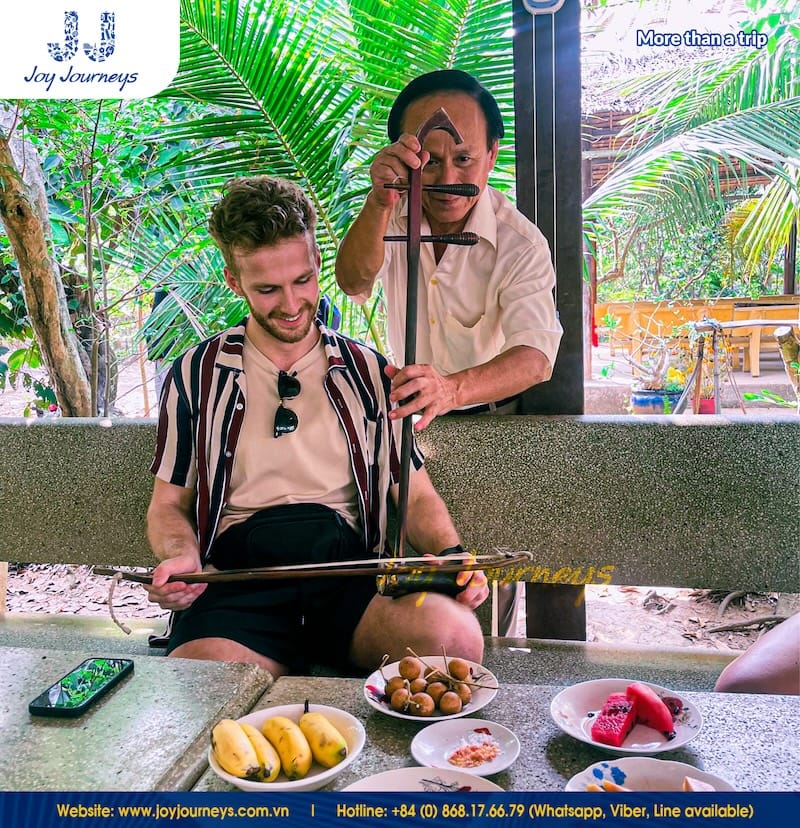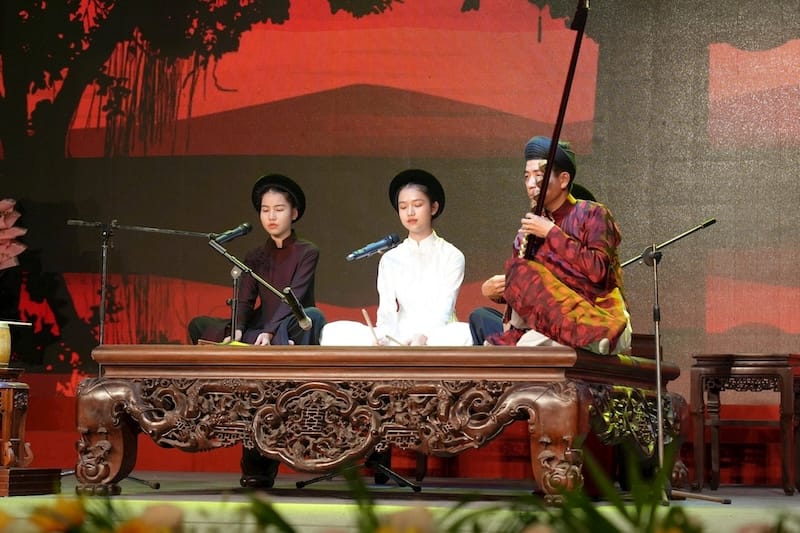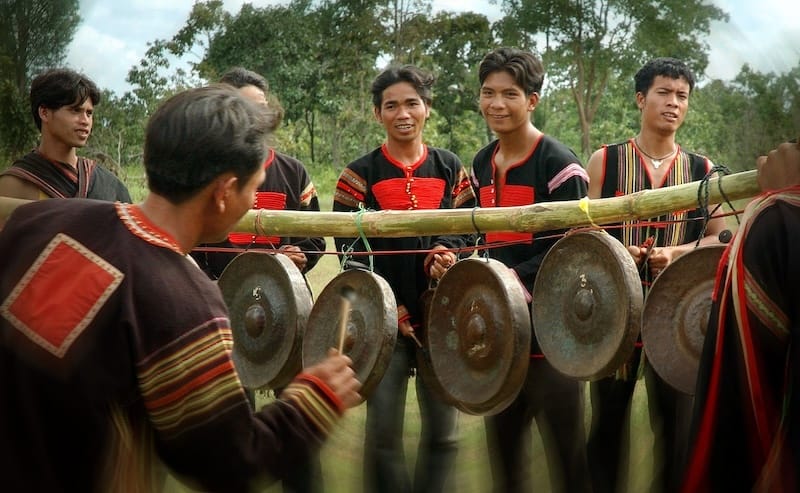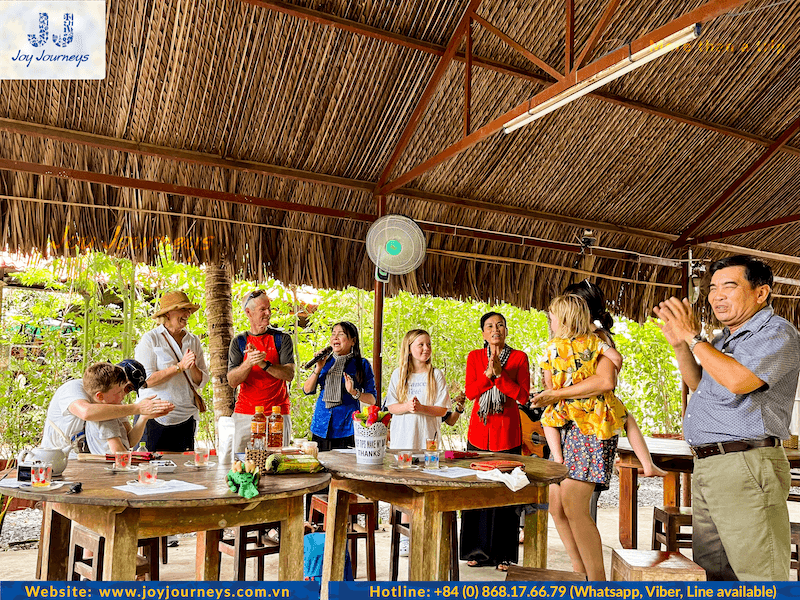Vietnamese folk music represents one of the most vibrant and diverse musical traditions in Southeast Asia, serving as a living testament to Vietnam’s rich cultural heritage. This ancient art form has evolved over thousands of years, weaving together the stories, emotions, and daily experiences of the Vietnamese people into sweet melodies that continue to resonate today.
From the haunting melodies of Ca trù to the communal joy of Quan họ singing, Vietnamese folk music offers a profound window into the soul of Vietnam and its enduring cultural identity.
Contents
- 1 Introduction to Vietnamese Folk Music
- 2 Types of Vietnamese Folk Music
- 3 Northern Vietnamese Folk Music
- 4 Central Vietnamese Folk Music
- 5 Southern Vietnamese Folk Music
- 6 Traditional Vietnamese Musical Instruments
- 7 String Instruments
- 8 Wind Instruments
- 9 Percussion Instruments
- 10 Notable Artists and Songs
- 11 Experiencing Folk Music of Vietnam
- 12 Enjoy Tropical Seasonal Fruit and Listen to Vietnamese Folk Music with Joy Journeys
- 13 FAQs
- 14 What are the key characteristics of Vietnamese folk music?
- 15 What is the difference between Ca trù and Quan họ?
- 16 Where can I see live performances of Vietnamese folk music?
Introduction to Vietnamese Folk Music
Traditional Vietnamese music encompasses a vast array of musical expressions that have been passed down through generations, each carrying the distinctive characteristics of Vietnam’s diverse regions and ethnic communities. The folk music of Vietnam is considerably diverse due to the country’s ethnic population, with each of Vietnam’s 54 ethnic groups contributing their own unique musical instruments, vocal styles, and performance traditions.
The history of Vietnamese folk music stretches back over millennia, with early influences from Chinese court music, Cham culture, and indigenous traditions creating a unique synthesis that defines Vietnamese musical identity. Royal Vietnamese court music first appeared after a successful seaborne raid against Champa led by Emperor Lý Thái Tông in 1044, when Cham women were taken as singers, dancers, and entertainers for the court. This cultural exchange laid the foundation for the complex musical traditions that would develop throughout Vietnam’s history.
Vietnamese folk music serves multiple functions within Vietnamese society, extending far beyond mere entertainment. It plays crucial roles in religious ceremonies, seasonal celebrations, courtship rituals, and community gatherings. The music reflects the lifestyle of Vietnamese people who live and work on the land and rivers, helping locals express their feelings, emotions, industriousness, generosity, and courage. This deep connection between music and daily life ensures that Vietnamese folk music remains a living, breathing art form rather than a museum piece.

Types of Vietnamese Folk Music
The types of Vietnamese folk music can be broadly categorized into three main regional traditions, each reflecting the unique geographical, cultural, and historical characteristics of their respective areas. This regional diversity creates a rich tapestry of musical expression that showcases the complexity and depth of Vietnamese cultural heritage.
Northern Vietnamese Folk Music
Northern Vietnamese folk music encompasses some of Vietnam’s most celebrated and internationally recognized musical forms. This region has produced several genres that have been designated as UNESCO Intangible Cultural Heritage, reflecting their global significance and cultural value.
Quan Họ represents one of the most distinctive forms of Northern Vietnamese folk music, characterized by its antiphonal singing style where groups of male and female singers engage in musical dialogue. These performances always occur in groups, with participants calling each other intimate family names such as Anh Cả (first brother), Chị Cả (first sister), creating a sense of community and kinship through music. The singers wear traditional costumes, with men donning turbans, umbrellas, and tunics, while women dress in Mớ Ba Mớ Bảy shirts and large round hats.
Ca Trù (also known as Hát Ả Đào) represents another jewel of Northern Vietnamese folk music, recognized by UNESCO as an intangible heritage requiring urgent protection. This sophisticated chamber music form combines poetry and music, featuring three main performers: a female singer using tongs, a male instrumentalist playing Đàn Đáy, and a spectator playing drums to punctuate the performance. Ca Trù was particularly popular among aristocrats and intellectuals from the 15th century onward, representing the pinnacle of refined musical expression.
Chầu Văn (Hát Văn) holds special significance as spiritual music associated with Mother Goddesses Worship, a prominent folk belief in Vietnam. This sacred form of Northern Vietnamese folk music plays a crucial role in religious ceremonies, with performances lasting 4-8 hours and featuring instruments such as Đàn Nguyệt (moon lute), small drums, tongs, cymbals, flutes, and Vietnamese monochords.

Central Vietnamese Folk Music
Central Vietnamese folk music is dominated by the sophisticated traditions of the former imperial capital, Huế. The most significant contribution from this region is Nhã Nhạc (Royal Court Music), which represents the pinnacle of Vietnamese classical music traditions.
Nhã Nhạc specifically refers to court music played from the Trần dynasty to the last Nguyễn dynasty, being synthesized and developed by the Nguyễn emperors. Influenced by Ming Chinese music, it slowly emerged in the royal court in the 1430s and became the standard for ceremonial and ritual music. This Central Vietnamese folk music tradition includes various categories: Nhã Nhạc (elegant music), Đại Nhạc (great music), and Tiểu Nhạc (small music), each serving different ceremonial functions.
The imperial court also featured elaborate dance traditions that complemented the musical performances, including Văn Vũ (civil servant dance) and Võ Vũ (military dance). These performances were designed to wish the emperor longevity and the country prosperity, reflecting the deep connection between music and political power in Vietnamese culture.
Southern Vietnamese Folk Music
Southern Vietnamese folk music is characterized by its more relaxed, improvisational style that reflects the region’s agricultural lifestyle and river-based culture. The most prominent form is Đờn Ca Tài Tử (Southern Amateur Music), which has been recognized as a UNESCO World Cultural Heritage.
Đờn Ca Tài Tử emerged in the late 19th century and reflects the lifestyle of Southern people who live and work on the land and rivers of the Mekong Delta region. This Southern Vietnamese folk music form features both scholarly and folk roots, combining lyrics with musical instruments in performances typically enjoyed by rural communities during their leisure time.
The instrumentation of Đờn Ca Tài Tử typically includes five traditional instruments: Đàn Tranh (zither), Đàn Tỳ Bà (pipa), Đàn Nguyệt (moon lute), Đàn Bầu (monochord), and Đàn Cò, sometimes supported by flute. The informal nature of these performances, where friends and neighbors gather to sing together without concern for elaborate costumes, reflects the democratic and community-oriented spirit of Southern Vietnamese folk music.
Traditional Vietnamese Musical Instruments
Vietnamese musical instruments form the backbone of the country’s folk music traditions, with each instrument contributing unique timbres and expressive capabilities to the overall musical landscape. These instruments can be broadly categorized into string, wind, and percussion families, each playing essential roles in different musical contexts.
String Instruments
The Vietnamese musical instruments family includes several distinctive stringed instruments that have become iconic symbols of Vietnamese musical culture.
- The Dan Bau (Monochord) stands as perhaps the most recognizable Vietnamese instrument, featuring a single string played with a flexible bamboo stick. Despite its seemingly simple design, the Dan Bau can create complex and expressive melodies, with its allure lying in its ability to evoke deep emotions. This instrument has become so significant that it has inspired dedicated compositions, with “Tinh bang co cai trong com” being arguably the only ode to a traditional Vietnamese musical instrument.
- The Dan Tranh (16-string Zither) represents one of the earliest traditional Vietnamese musical instruments, characterized by its numerous strings that produce enchanting and melodic sounds. This instrument’s versatility and vibration make it a cultural icon, symbolizing the depth and sophistication of Vietnamese musical traditions.
- The Dan Nguyet (Moon-shaped Lute) adds a poetic and aesthetic dimension to Vietnamese music with its unique crescent moon design. This instrument can express many different emotional nuances, from gentle and soft to firm and vibrant, making it popular in both traditional and contemporary musical genres.
Wind Instruments
Vietnamese wind instruments contribute essential melodic and harmonic elements to folk music performances, with each instrument offering distinct tonal qualities and expressive capabilities.
- The Sao Truc (Vietnamese bamboo flute) emerges as a wind instrument celebrated for its clear and pure tones. Widely used in traditional and folk music, the Sao Truc’s melodic tunes evoke a sense of tranquility and nostalgia, representing a bridge between the natural world and cultural expressions.
- The Ken Bau is a double-wind instrument commonly used in weddings, funerals, celebrations, and especially in Nhã Nhạc (Vietnamese Court Music). The special characteristic of Ken Bau is its bell made from the dry peel of a gourd, producing strong, resonant, and high-pitched sounds that can express various emotions from happy and bright to gloomy and tragic.
Percussion Instruments

Percussion instruments provide rhythmic foundation and ceremonial significance to Vietnamese folk music, with several instruments holding particular cultural importance.
The Trong Com (rice drum) derives its name from the practice of using sticky rice to rub the drum’s surface to determine sound quality. Its rhythmic beats provide the foundation for various musical performances, serving as a driving force in traditional and ceremonial contexts. This instrument has retained its cultural value and become one of the most unique and beloved traditional Vietnamese musical instruments.
Cong Chieng (gongs) serve as fundamental percussion instruments in traditional Vietnamese music and rituals, with their resonant and distinctive sounds marking key moments and transitions in performances. The Central Highlands gong culture is recognized not simply as a musical instrument but as a type of cultural heritage that preserves historical development from the earliest times.
Notable Artists and Songs
The landscape of Vietnamese folk music has been shaped by countless talented artists who have preserved and transmitted these traditions across generations. While many traditional performers remain anonymous, their contributions live on through the famous Vietnamese folk songs that continue to be performed today.
Famous Vietnamese folk songs from the Northern region include classics such as “Cò Lả,” which captures the essence of rural life and was originally sung by hard-working farmers. “Trống Cơm” celebrates the traditional drum instrument and evokes nostalgia among the Vietnamese diaspora during Lunar New Year celebrations. “Qua Cầu Gió Bay” represents an enduring quan ho folk song that tells tales of love between young couples, blending romance with the courage to defy societal norms.
Southern Vietnam has contributed memorable pieces such as “Lý Mỹ Hưng,” which praises the beauty and abundance of rural villages. “Còn Thương Rau Đắng Mọc Sau Hè” was composed by musician Bắc Sơn based on a poem by Nguyệt Lãng, telling the story of two sisters reminiscing about past love.
Experiencing Folk Music of Vietnam
For those interested in experiencing Vietnamese folk music firsthand, numerous opportunities exist both within Vietnam and internationally. The music of Vietnam can be encountered in various settings, from formal concert halls to intimate community gatherings.
Within Vietnam, cultural centers and traditional venues regularly host performances of Asian folk music, including Vietnamese traditions. The Vietnam National Academy of Music frequently presents concerts that blend traditional and contemporary elements, such as the recent performance featuring works imbued with chèo (popular opera) and chầu văn (spiritual singing).
International audiences can access Vietnamese folk music through various online platforms, cultural festivals, and Vietnamese cultural centers worldwide. Many universities with ethnomusicology programs also offer courses and performances featuring traditional Vietnamese music.
For those interested in learning to play Vietnamese musical instruments, several resources are available, including instructional videos, cultural workshops, and traditional music schools. The growing interest in world music has led to increased availability of Vietnamese instruments and instruction materials outside of Vietnam.
Enjoy Tropical Seasonal Fruit and Listen to Vietnamese Folk Music with Joy Journeys
Joy Journeys offers unique opportunities to experience Vietnamese folk music in its authentic cultural context through their carefully curated Mekong Delta tours. Our “Local ‘Less-Known’ Mekong Delta My Tho 1-Day Tour” includes traditional Southern Vietnamese folk music performances as part of the cultural immersion experience.
During these tours, visitors can enjoy live performances of Southern Vietnamese folk music while sampling tropical fruits and experiencing the rural lifestyle that inspired these musical traditions. The combination of Vietnam culture and natural beauty creates an ideal setting for appreciating the deep connections between music, environment, and daily life that characterize Vietnamese folk traditions.
Joy Journeys’ commitment to authentic cultural experiences ensures that visitors encounter genuine Vietnamese folk music performances rather than commercialized tourist shows. Their small group approach (maximum 10 travelers) allows for intimate musical experiences where guests can interact with local musicians and learn about the cultural significance of the songs being performed.

FAQs
What are the key characteristics of Vietnamese folk music?
Vietnamese folk music is characterized by its pentatonic scale system, use of traditional instruments, close connection to daily life and rituals, and regional diversity. The music often features call-and-response patterns, improvisation within traditional frameworks, and deep integration with poetry and storytelling. Each regional style has distinct characteristics: Northern music tends to be more structured and ceremonial, Central music reflects court traditions, while Southern music is more relaxed and improvisational.
What is the difference between Ca trù and Quan họ?
Ca trù is a sophisticated chamber music form that combines poetry and music, typically performed by three people (female singer, male instrumentalist, and spectator with drum) in intimate settings. It was historically popular among aristocrats and intellectuals. Quan họ, on the other hand, is a communal folk singing tradition performed in groups, featuring antiphonal singing between male and female groups during festivals and social gatherings. Quan họ is more participatory and community-oriented, while Ca trù is more refined and artistic.
Where can I see live performances of Vietnamese folk music?
Live performances of Vietnamese folk music can be experienced at various venues including the Vietnam National Academy of Music, cultural centers in major Vietnamese cities, traditional festivals, and through cultural tours like those offered by Joy Journeys. Many temples and pagodas also host traditional music during religious ceremonies. International audiences can find performances at Vietnamese cultural centers, world music festivals, and universities with ethnomusicology programs.
Immerse yourself in the rich traditions of Vietnamese folk music and discover how these ancient melodies continue to express the heart and soul of Vietnamese culture. Experience authentic performances in their natural setting through Joy Journeys’ cultural tours, where music, nature, and tradition come together to create unforgettable memories. Book your cultural journey with Joy Journeys and let the sounds of Vietnam transport you through centuries of musical heritage.



Related Posts
Saigon’s “Flower Market Replica”: Where To Find Them
Ho Chi Minh City’s floral charm is not limited to its bustling wholesale markets. Imagine wandering through a place where vibrant petals, fragrant blooms, and the spirit of traditional Vietnamese markets come alive—without the overwhelming crowds. A flower market replica captures that magic, blending the beauty of fresh flowers with the charm of a curated, […]
Is it Safe to Travel to Vietnam Right Now? A Complete 2025 Guide
Vietnam has emerged as one of Southeast Asia’s most captivating destinations, drawing millions of visitors annually with its rich culture, stunning landscapes, and incredible cuisine. However, many travelers still ask: Is it safe to travel to Vietnam right now? This comprehensive guide provides you with everything you need to know about Vietnam travel safety in […]
Ho Chi Minh Cu Chi Tunnels Tour: The Ultimate Guide
The Cu Chi Tunnels stand as one of Vietnam’s most remarkable historical sites, offering visitors a profound glimpse into the ingenuity and resilience displayed during the Vietnam War. For travelers, a Ho Chi Minh Cu Chi tunnels tour represents an essential experience that combines education, adventure, and deep cultural understanding. This comprehensive guide will help […]